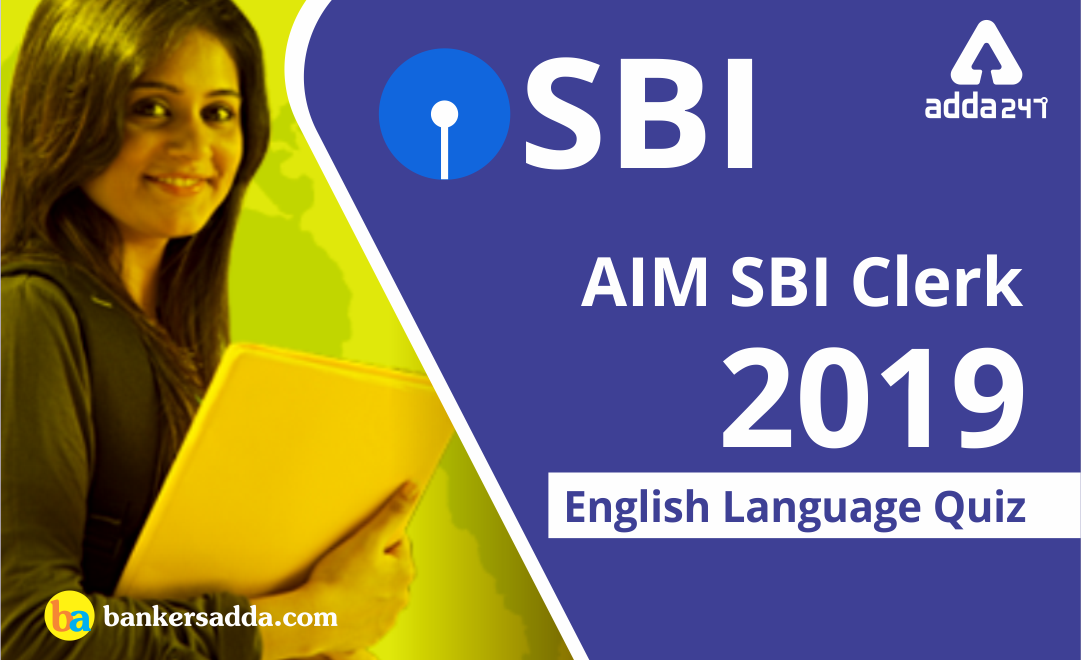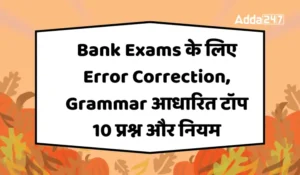SBI Clerk Prelims English Questions (Day-27)
Dear students, The State Bank of India conducts a two-tier examination to recruit Clerks (Junior Associates) at regular intervals. Thus, the English Language plays a crucial role in sailing through all the stages of SBI Clerk exam. Here is a quiz on the English Language to let you practice the latest pattern English Questions for SBI Clerk 2019-20.
Directions (1-5): In the following questions, a sentence is given with four highlighted words. Choose the combination of words that mentions the words which are either misspelt or grammatically incorrect or contextually meaningless. If all the highlighted words are correct, choose option (E) i.e. “All are correct” as your answer choice.
Q1. When the results of the April elections in Israel were announced, Benjamin Netanyahu, whose Likud party won 35 seats in the 120-member Parliament, was the winner.
results
announced
Parliament
winner
All are correct
Solution:
All are correct
Q2. Mr. Netanyahu is a surviver. He will continue to lead the Likud in the September elections and appears better-placed than his rivals to form a coalition government.
surviver
elections
rivals
coalition
All are correct
Solution:
The correct spelling is 'survivor'
Q3. By refusing to back Mr. Netanyahu over the conscription bill, Mr. Lieberman is further trying to weaken this left-right battlle and bring into focus secular-versus-religious issues.
refusing
further
battlle
religious
All are correct
Solution:
The correct spelling is 'battle'.
Q4. The challenge before Mr. Netanyahu is to fight grow political and legal odds in an election just months away.
challenge
grow
legal
months
All are correct
Solution:
'Grow' is incorrectly used here and instead 'growing' should be used here.
Q5. His self-assurance boosted by a massive popular mandate, Prime Minister Narendra Modi constitutid a 58-member Council of Ministers, with more than 20 fresh faces, on Thursday.
boosted
mandate
constitutid
Ministers
All are correct
Solution:
The correct spelling is 'constituted'.
Directions (6-10): In the passage given below there are blanks which are numbered from 6 to 10. They are to be filled with the options given below the passage against each of the respective numbers. Find out the appropriate word in each case which can most suitably complete the sentence without altering its meaning.
Q6. Non-banking financial companies, already reeling under a painful liquidity crisis, are up against a fresh (6)………………….. in the form of new regulatory norms set by the Reserve Bank of India. The central bank has (7)……………… draft norms on liquidity risk management for deposit taking and non-deposit taking NBFCs. According to these proposed rules, NBFCs would have to (8)……………… with a higher liquidity coverage ratio (LCR), which is the proportion of assets that an NBFC needs to hold in the form of high-quality liquid assets that can be quickly and easily converted into cash. The new norms, which are expected to be (9)………………… by the RBI over four years starting from April 2020, would likely put significant pressure on the margins of NBFCs. Under these norms, NBFCs would have to maintain their LCR at 60% of net cash outflows initially and improve it to 100% by April 2024. If the norms are implemented, NBFCs may be forced to park a (10)……………… share of their money in low-risk liquid assets, such as government bonds, which yield much lower returns than high-risk illiquid assets. The strict norms have to be seen in the context of the present crisis where even prominent NBFCs are struggling to meet their obligations to various lenders.
object
challenge
acceptance
decide
claiming
Solution:
'challenge' is grammatically and contextually correct.
Q7. Non-banking financial companies, already reeling under a painful liquidity crisis, are up against a fresh (6)………………….. in the form of new regulatory norms set by the Reserve Bank of India. The central bank has (7)……………… draft norms on liquidity risk management for deposit taking and non-deposit taking NBFCs. According to these proposed rules, NBFCs would have to (8)……………… with a higher liquidity coverage ratio (LCR), which is the proportion of assets that an NBFC needs to hold in the form of high-quality liquid assets that can be quickly and easily converted into cash. The new norms, which are expected to be (9)………………… by the RBI over four years starting from April 2020, would likely put significant pressure on the margins of NBFCs. Under these norms, NBFCs would have to maintain their LCR at 60% of net cash outflows initially and improve it to 100% by April 2024. If the norms are implemented, NBFCs may be forced to park a (10)……………… share of their money in low-risk liquid assets, such as government bonds, which yield much lower returns than high-risk illiquid assets. The strict norms have to be seen in the context of the present crisis where even prominent NBFCs are struggling to meet their obligations to various lenders.
create
manage
released
damaged
reviving
Solution:
'released' is grammatically and contextually correct.
Q8. Non-banking financial companies, already reeling under a painful liquidity crisis, are up against a fresh (6)………………….. in the form of new regulatory norms set by the Reserve Bank of India. The central bank has (7)……………… draft norms on liquidity risk management for deposit taking and non-deposit taking NBFCs. According to these proposed rules, NBFCs would have to (8)……………… with a higher liquidity coverage ratio (LCR), which is the proportion of assets that an NBFC needs to hold in the form of high-quality liquid assets that can be quickly and easily converted into cash. The new norms, which are expected to be (9)………………… by the RBI over four years starting from April 2020, would likely put significant pressure on the margins of NBFCs. Under these norms, NBFCs would have to maintain their LCR at 60% of net cash outflows initially and improve it to 100% by April 2024. If the norms are implemented, NBFCs may be forced to park a (10)……………… share of their money in low-risk liquid assets, such as government bonds, which yield much lower returns than high-risk illiquid assets. The strict norms have to be seen in the context of the present crisis where even prominent NBFCs are struggling to meet their obligations to various lenders.
obeying
satisfying
neglected
comply
withheld
Solution:
'comply' means act in accordance with a wish or command and
Q9. Non-banking financial companies, already reeling under a painful liquidity crisis, are up against a fresh (6)………………….. in the form of new regulatory norms set by the Reserve Bank of India. The central bank has (7)……………… draft norms on liquidity risk management for deposit taking and non-deposit taking NBFCs. According to these proposed rules, NBFCs would have to (8)……………… with a higher liquidity coverage ratio (LCR), which is the proportion of assets that an NBFC needs to hold in the form of high-quality liquid assets that can be quickly and easily converted into cash. The new norms, which are expected to be (9)………………… by the RBI over four years starting from April 2020, would likely put significant pressure on the margins of NBFCs. Under these norms, NBFCs would have to maintain their LCR at 60% of net cash outflows initially and improve it to 100% by April 2024. If the norms are implemented, NBFCs may be forced to park a (10)……………… share of their money in low-risk liquid assets, such as government bonds, which yield much lower returns than high-risk illiquid assets. The strict norms have to be seen in the context of the present crisis where even prominent NBFCs are struggling to meet their obligations to various lenders.
failing
resolution
enforcing
effect
implemented
Solution:
'implemented' is grammatically and contextually correct.
Q10. Non-banking financial companies, already reeling under a painful liquidity crisis, are up against a fresh (6)………………….. in the form of new regulatory norms set by the Reserve Bank of India. The central bank has (7)……………… draft norms on liquidity risk management for deposit taking and non-deposit taking NBFCs. According to these proposed rules, NBFCs would have to (8)……………… with a higher liquidity coverage ratio (LCR), which is the proportion of assets that an NBFC needs to hold in the form of high-quality liquid assets that can be quickly and easily converted into cash. The new norms, which are expected to be (9)………………… by the RBI over four years starting from April 2020, would likely put significant pressure on the margins of NBFCs. Under these norms, NBFCs would have to maintain their LCR at 60% of net cash outflows initially and improve it to 100% by April 2024. If the norms are implemented, NBFCs may be forced to park a (10)……………… share of their money in low-risk liquid assets, such as government bonds, which yield much lower returns than high-risk illiquid assets. The strict norms have to be seen in the context of the present crisis where even prominent NBFCs are struggling to meet their obligations to various lenders.
compel
importance
significant
represent
symbol
Solution:
'significant' is grammatically and contextually correct.
Directions (11-15): In each of the following Questions a sentence is divided into four parts A, B, C and D. Rearrange the following parts (A), (B), (C) and (D) in the proper sequence to form a meaningful sentence and then answer the questions given below.
Q11. (A) on his new government’s foreign policy focus
(B) Prime Minister Narendra Modi’s decision to invite
(B) Prime Minister Narendra Modi’s decision to invite
(C) leaders of the other six BIMSTEC countries to the swearing-in
(D) ceremony of his Council of Ministers sends out several messages
BCDA
ADBC
CDAB
DBAC
DCAB
Solution:
The correct rearrangement is BCDA.
Q12.
(A) India is emerging as a
(A) India is emerging as a
(B) 800 million mobile phone users,
(C) half of whom own a smartphone
(D) major ‘data economy’ with over
BCDA
ADBC
CDAB
DBAC
DCAB
Solution:
The correct rearrangement is ADBC.
Q13.
(A) had very sound macroeconomics
(A) had very sound macroeconomics
(B) over the last five years
(C) if you look at the
(D) state of the economy, we’ve
BCDA
ADBC
CDAB
DBAC
DCAB
Solution:
The correct rearrangement is CDAB.
Q14.
(A) over the years in its emphasis,
(A) over the years in its emphasis,
(B) has witnessed several changes
(C) approaches, strategies and programmes
(D) rural development in India
BCDA
ADBC
CDAB
DBAC
DCAB
Solution:
The correct rearrangement is DBAC.
Q15.
(A) 2011 earthquake, which measured
(A) 2011 earthquake, which measured
(B) 6.9 on the Richter scale
(C) seriously by the September
(D) Sikkim was affected
BCDA
ADBC
CDAB
DBAC
DCAB
Solution:
The correct rearrangement is DCAB.





 Practice for English Section: 15 Cloze T...
Practice for English Section: 15 Cloze T...
 Bank Exams के लिए Error Correction, Gram...
Bank Exams के लिए Error Correction, Gram...
 English Quiz For NIACL AO Mains 2024 Exa...
English Quiz For NIACL AO Mains 2024 Exa...








